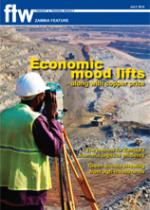The fortunes of the Zambian
logistics industry are a reflection
of the country’s over-dependence
on copper.
About two-thirds of Zambian
export earnings are generated by
copper.
The freight industry boomed and
grew in 2008, when the price hit
more than $8 000 a ton, and the
Zambian economy grew by 5.8%.
By December the price had fallen
more than 60%. The kwacha fell by
70% against the dollar, and mines
started making losses and closing –
leading inevitably to retrenchments
and consolidation of the freight
industry.
Things are looking rosier with
a recovery in the copper price, but
logistics companies continue to keep
a wary eye on the copper prices.
What happens in the freight
industry is a good barometer of the
economy, and Zambia has been
warned since at least the 1990s that it
is over-dependent on copper.
Government has recognised this
threat. Speaking at a Copperbelt
business seminar on trade and
investment opportunities earlier
this year, Zambian finance and
national planning minister Situmbeko
Musokotwane said the country’s
dependence on copper as the only
large source of economic growth and
foreign exchange earnings had led to
tremendous economic volatility over
the past decade.
Government was attempting to
grow sectors such as agriculture,
tourism and manufacturing to
diversify the economy. It also wanted
to see more value being added to the
copper before it was exported.
“This can only be achieved through
investment into processing that adds
value in the sector. As government we
will continue to focus on providing
a welcoming environment to both
domestic and foreign investment,”
he said.
Opportunities for Zambia and other
commodity-rich African countries
are highlighted in the United
Nations Conference on Trade
and Investment Economic
Development in Africa Report
2010.
It says Africa should
take steps to ensure that
its growing economic
interactions with large
developing countries, including
China, India, and Brazil, result in
economic diversification rather
than simply the sale of African
commodities and raw materials – the
traditional pattern of the continent’s
relations with the industrialised
North.
The study warns that so far, trade
and investment flows with the South
are reinforcing a longstanding trend
in which African countries export
farm produce, minerals, ores and
crude oil, and import manufactured
goods.
It says this situation should be
reversed while the South-South
trend is still in its early stages. A
repeat of the traditional pattern
will not help African
countries to reduce their
traditional dependence on exports of
commodities and low-value-added
goods.
In 2008, Africa’s total trade with
developing countries, including
African countries, for the first time
exceeded Africa’s total trade with the
EU, traditionally its major trading
partner.
With the continuing growth of
large developing countries, together
with weaker growth prospects in
advanced economies, the economic
relationships linking Africa to other
developing regions can be expected
to grow in relative importance, says
the report.
Zambia’s fortunes rise and fall with copper price
13 Aug 2010 - by Ed Richardson
0 Comments
Zambia 2010

13 Aug 2010
13 Aug 2010
13 Aug 2010
13 Aug 2010
13 Aug 2010
13 Aug 2010
13 Aug 2010
Border Beat
Featured Jobs
New
New
